Report on Managing Strategic Resources: TATA Steel's Strategies
VerifiedAdded on 2022/11/17
|11
|2542
|264
Report
AI Summary
This report provides a comprehensive analysis of TATA Steel's strategic resource management, encompassing its supply chain and logistics operations, value chain framework, and sustainability initiatives. The report begins with an overview of TATA Steel, detailing its global presence and value chain from mining to finished steel products. It then examines the company's supply chain and logistics management, emphasizing the integration of business activities for value creation. The report further explores the linkages between TATA Steel's activities and various business theories, including the value chain framework and its dimensions, such as intra-firm, inter-firm, and external stakeholders. Finally, the report investigates TATA Steel's sustainability practices, including corporate social responsibility, environmental protection, and social welfare programs, highlighting the company's commitment to the triple-bottom-line approach and its achievements in sustainability indices. The report concludes by emphasizing the importance of integrated strategic planning, financial systems, and human resources in effective resource management and sustainable business practices.
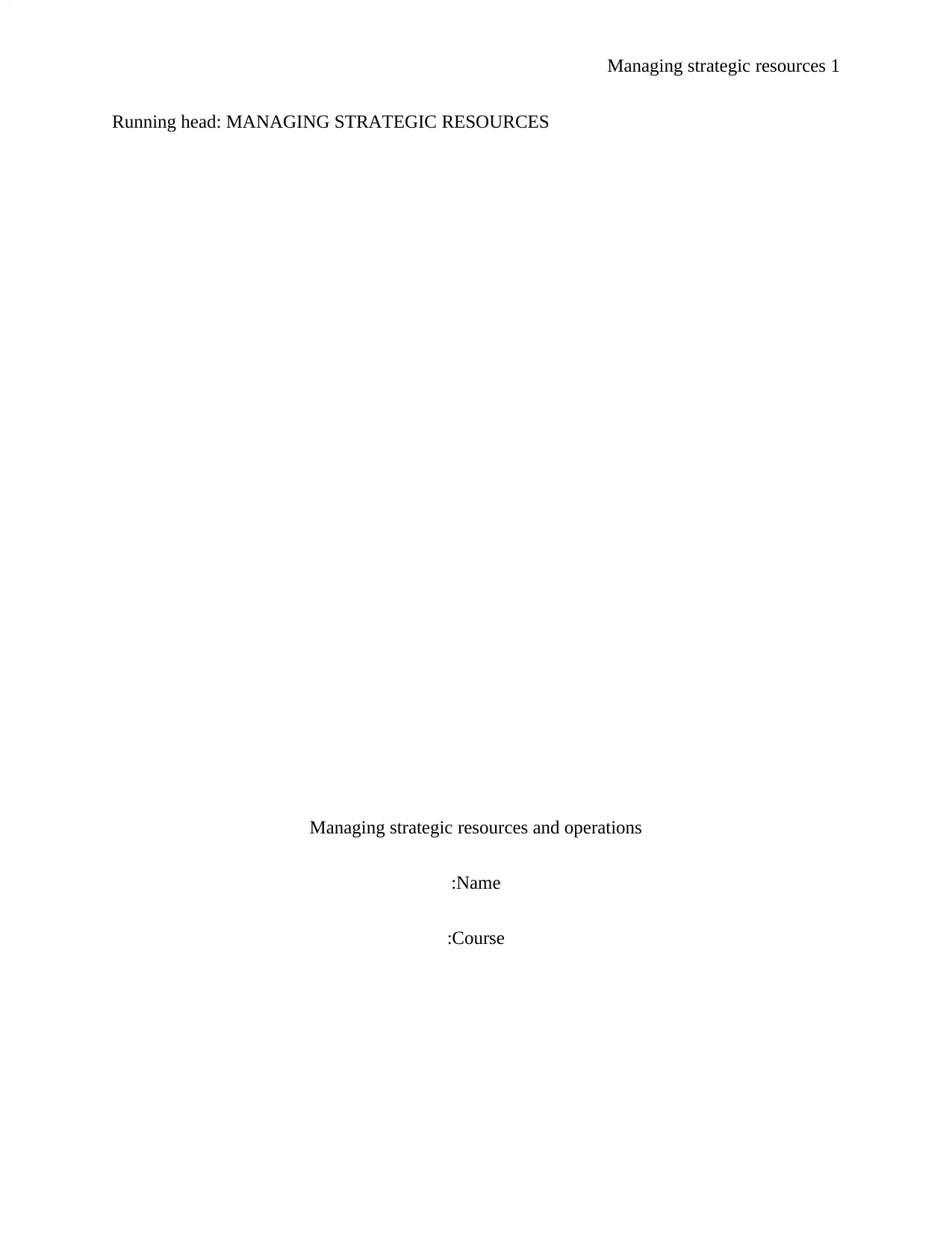
1Managing strategic resources
Running head: MANAGING STRATEGIC RESOURCES
Managing strategic resources and operations
Name:
Course:
Running head: MANAGING STRATEGIC RESOURCES
Managing strategic resources and operations
Name:
Course:
Paraphrase This Document
Need a fresh take? Get an instant paraphrase of this document with our AI Paraphraser
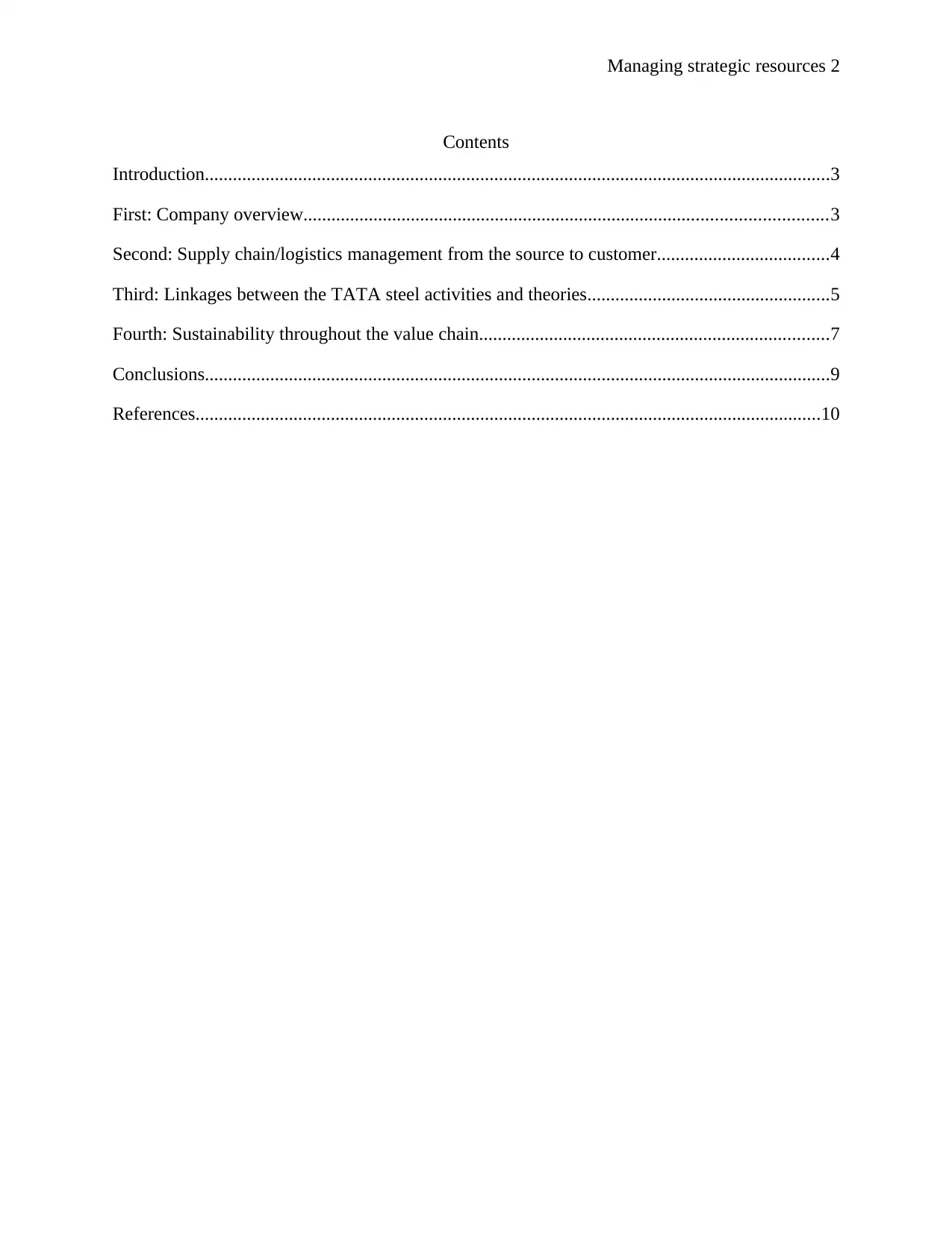
2Managing strategic resources
Contents
Introduction......................................................................................................................................3
First: Company overview................................................................................................................3
Second: Supply chain/logistics management from the source to customer.....................................4
Third: Linkages between the TATA steel activities and theories....................................................5
Fourth: Sustainability throughout the value chain...........................................................................7
Conclusions......................................................................................................................................9
References......................................................................................................................................10
Contents
Introduction......................................................................................................................................3
First: Company overview................................................................................................................3
Second: Supply chain/logistics management from the source to customer.....................................4
Third: Linkages between the TATA steel activities and theories....................................................5
Fourth: Sustainability throughout the value chain...........................................................................7
Conclusions......................................................................................................................................9
References......................................................................................................................................10
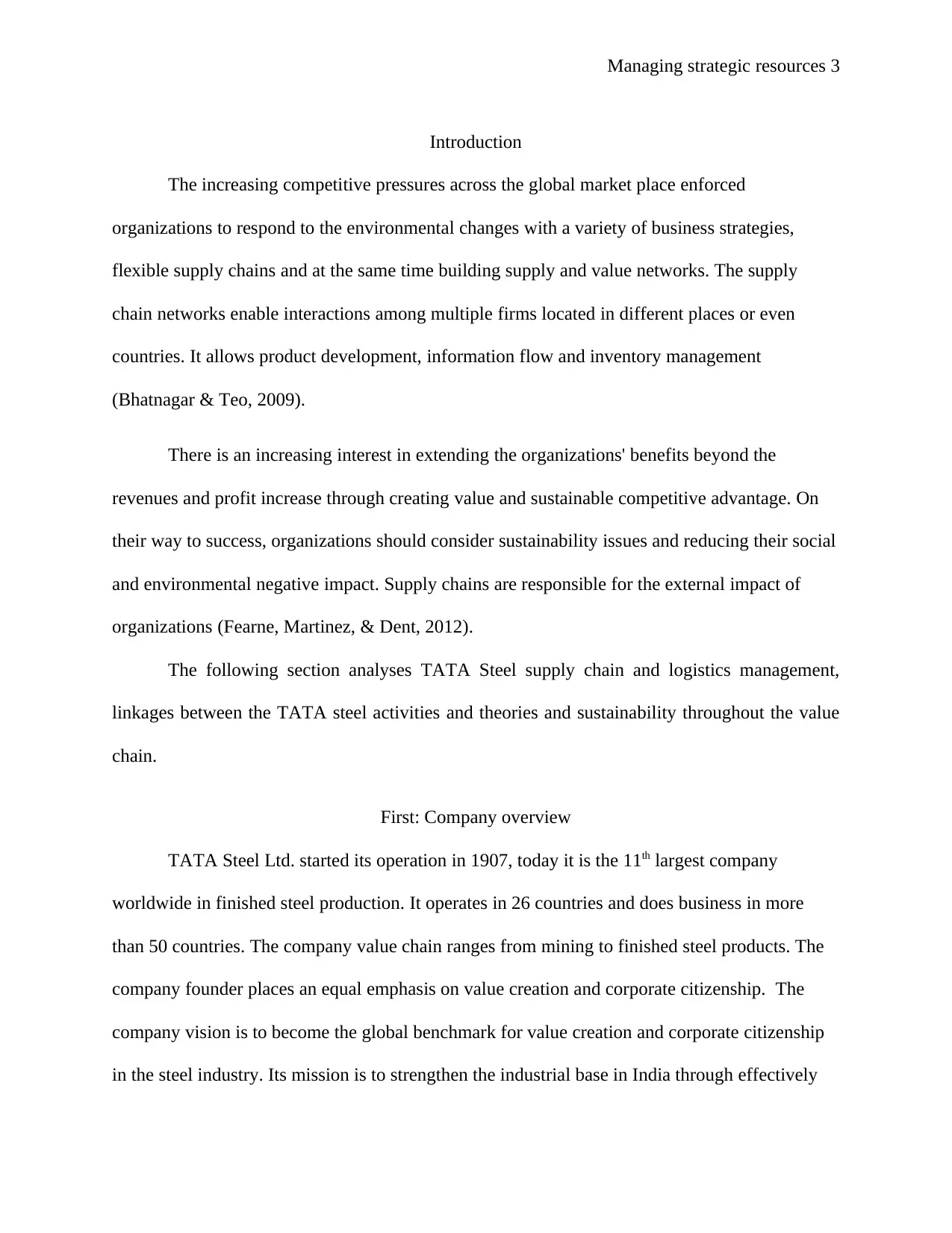
3Managing strategic resources
Introduction
The increasing competitive pressures across the global market place enforced
organizations to respond to the environmental changes with a variety of business strategies,
flexible supply chains and at the same time building supply and value networks. The supply
chain networks enable interactions among multiple firms located in different places or even
countries. It allows product development, information flow and inventory management
(Bhatnagar & Teo, 2009).
There is an increasing interest in extending the organizations' benefits beyond the
revenues and profit increase through creating value and sustainable competitive advantage. On
their way to success, organizations should consider sustainability issues and reducing their social
and environmental negative impact. Supply chains are responsible for the external impact of
organizations (Fearne, Martinez, & Dent, 2012).
The following section analyses TATA Steel supply chain and logistics management,
linkages between the TATA steel activities and theories and sustainability throughout the value
chain.
First: Company overview
TATA Steel Ltd. started its operation in 1907, today it is the 11th largest company
worldwide in finished steel production. It operates in 26 countries and does business in more
than 50 countries. The company value chain ranges from mining to finished steel products. The
company founder places an equal emphasis on value creation and corporate citizenship. The
company vision is to become the global benchmark for value creation and corporate citizenship
in the steel industry. Its mission is to strengthen the industrial base in India through effectively
Introduction
The increasing competitive pressures across the global market place enforced
organizations to respond to the environmental changes with a variety of business strategies,
flexible supply chains and at the same time building supply and value networks. The supply
chain networks enable interactions among multiple firms located in different places or even
countries. It allows product development, information flow and inventory management
(Bhatnagar & Teo, 2009).
There is an increasing interest in extending the organizations' benefits beyond the
revenues and profit increase through creating value and sustainable competitive advantage. On
their way to success, organizations should consider sustainability issues and reducing their social
and environmental negative impact. Supply chains are responsible for the external impact of
organizations (Fearne, Martinez, & Dent, 2012).
The following section analyses TATA Steel supply chain and logistics management,
linkages between the TATA steel activities and theories and sustainability throughout the value
chain.
First: Company overview
TATA Steel Ltd. started its operation in 1907, today it is the 11th largest company
worldwide in finished steel production. It operates in 26 countries and does business in more
than 50 countries. The company value chain ranges from mining to finished steel products. The
company founder places an equal emphasis on value creation and corporate citizenship. The
company vision is to become the global benchmark for value creation and corporate citizenship
in the steel industry. Its mission is to strengthen the industrial base in India through effectively
⊘ This is a preview!⊘
Do you want full access?
Subscribe today to unlock all pages.

Trusted by 1+ million students worldwide
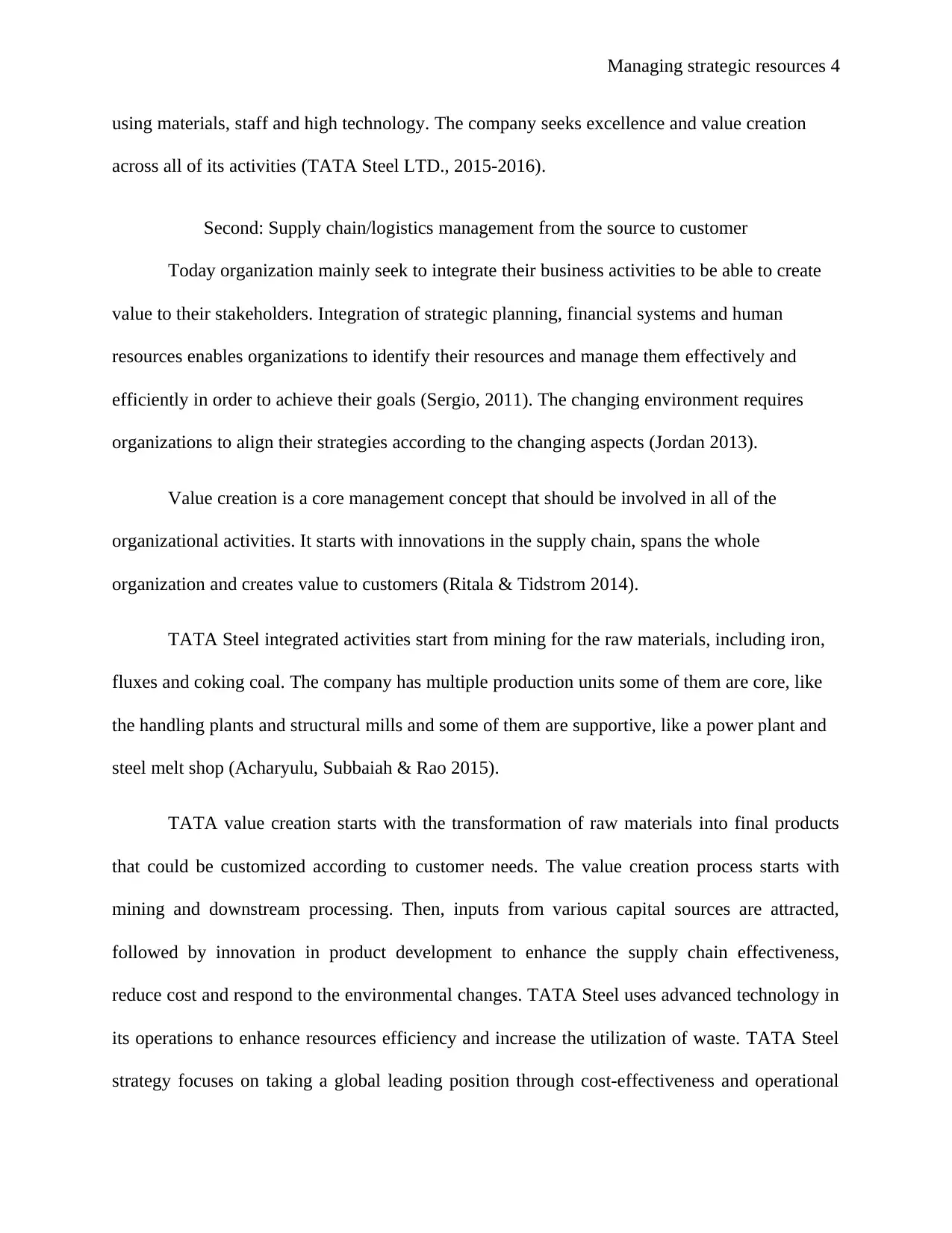
4Managing strategic resources
using materials, staff and high technology. The company seeks excellence and value creation
across all of its activities (TATA Steel LTD., 2015-2016).
Second: Supply chain/logistics management from the source to customer
Today organization mainly seek to integrate their business activities to be able to create
value to their stakeholders. Integration of strategic planning, financial systems and human
resources enables organizations to identify their resources and manage them effectively and
efficiently in order to achieve their goals (Sergio, 2011). The changing environment requires
organizations to align their strategies according to the changing aspects (Jordan 2013).
Value creation is a core management concept that should be involved in all of the
organizational activities. It starts with innovations in the supply chain, spans the whole
organization and creates value to customers (Ritala & Tidstrom 2014).
TATA Steel integrated activities start from mining for the raw materials, including iron,
fluxes and coking coal. The company has multiple production units some of them are core, like
the handling plants and structural mills and some of them are supportive, like a power plant and
steel melt shop (Acharyulu, Subbaiah & Rao 2015).
TATA value creation starts with the transformation of raw materials into final products
that could be customized according to customer needs. The value creation process starts with
mining and downstream processing. Then, inputs from various capital sources are attracted,
followed by innovation in product development to enhance the supply chain effectiveness,
reduce cost and respond to the environmental changes. TATA Steel uses advanced technology in
its operations to enhance resources efficiency and increase the utilization of waste. TATA Steel
strategy focuses on taking a global leading position through cost-effectiveness and operational
using materials, staff and high technology. The company seeks excellence and value creation
across all of its activities (TATA Steel LTD., 2015-2016).
Second: Supply chain/logistics management from the source to customer
Today organization mainly seek to integrate their business activities to be able to create
value to their stakeholders. Integration of strategic planning, financial systems and human
resources enables organizations to identify their resources and manage them effectively and
efficiently in order to achieve their goals (Sergio, 2011). The changing environment requires
organizations to align their strategies according to the changing aspects (Jordan 2013).
Value creation is a core management concept that should be involved in all of the
organizational activities. It starts with innovations in the supply chain, spans the whole
organization and creates value to customers (Ritala & Tidstrom 2014).
TATA Steel integrated activities start from mining for the raw materials, including iron,
fluxes and coking coal. The company has multiple production units some of them are core, like
the handling plants and structural mills and some of them are supportive, like a power plant and
steel melt shop (Acharyulu, Subbaiah & Rao 2015).
TATA value creation starts with the transformation of raw materials into final products
that could be customized according to customer needs. The value creation process starts with
mining and downstream processing. Then, inputs from various capital sources are attracted,
followed by innovation in product development to enhance the supply chain effectiveness,
reduce cost and respond to the environmental changes. TATA Steel uses advanced technology in
its operations to enhance resources efficiency and increase the utilization of waste. TATA Steel
strategy focuses on taking a global leading position through cost-effectiveness and operational
Paraphrase This Document
Need a fresh take? Get an instant paraphrase of this document with our AI Paraphraser
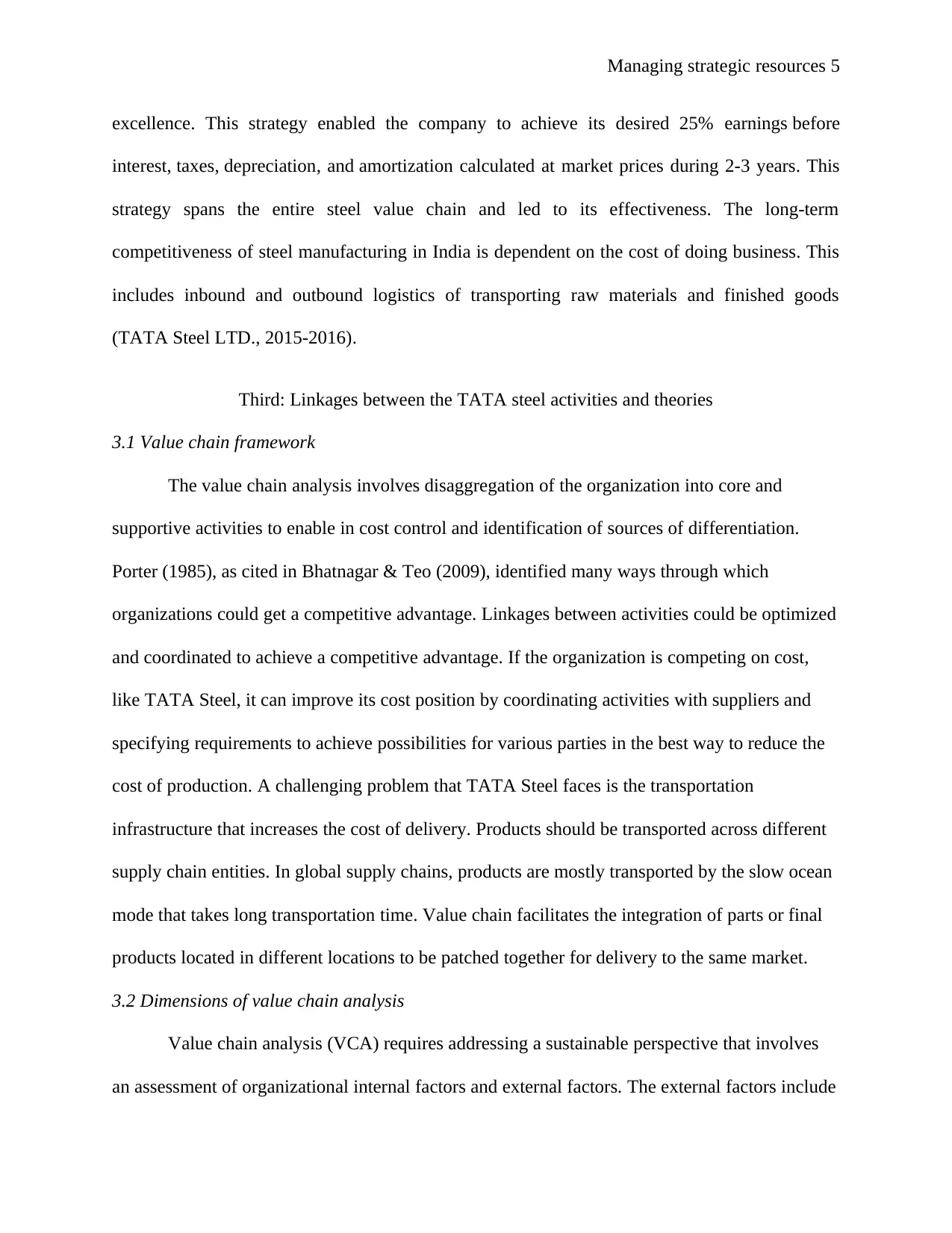
5Managing strategic resources
excellence. This strategy enabled the company to achieve its desired 25% earnings before
interest, taxes, depreciation, and amortization calculated at market prices during 2-3 years. This
strategy spans the entire steel value chain and led to its effectiveness. The long-term
competitiveness of steel manufacturing in India is dependent on the cost of doing business. This
includes inbound and outbound logistics of transporting raw materials and finished goods
(TATA Steel LTD., 2015-2016).
Third: Linkages between the TATA steel activities and theories
3.1 Value chain framework
The value chain analysis involves disaggregation of the organization into core and
supportive activities to enable in cost control and identification of sources of differentiation.
Porter (1985), as cited in Bhatnagar & Teo (2009), identified many ways through which
organizations could get a competitive advantage. Linkages between activities could be optimized
and coordinated to achieve a competitive advantage. If the organization is competing on cost,
like TATA Steel, it can improve its cost position by coordinating activities with suppliers and
specifying requirements to achieve possibilities for various parties in the best way to reduce the
cost of production. A challenging problem that TATA Steel faces is the transportation
infrastructure that increases the cost of delivery. Products should be transported across different
supply chain entities. In global supply chains, products are mostly transported by the slow ocean
mode that takes long transportation time. Value chain facilitates the integration of parts or final
products located in different locations to be patched together for delivery to the same market.
3.2 Dimensions of value chain analysis
Value chain analysis (VCA) requires addressing a sustainable perspective that involves
an assessment of organizational internal factors and external factors. The external factors include
excellence. This strategy enabled the company to achieve its desired 25% earnings before
interest, taxes, depreciation, and amortization calculated at market prices during 2-3 years. This
strategy spans the entire steel value chain and led to its effectiveness. The long-term
competitiveness of steel manufacturing in India is dependent on the cost of doing business. This
includes inbound and outbound logistics of transporting raw materials and finished goods
(TATA Steel LTD., 2015-2016).
Third: Linkages between the TATA steel activities and theories
3.1 Value chain framework
The value chain analysis involves disaggregation of the organization into core and
supportive activities to enable in cost control and identification of sources of differentiation.
Porter (1985), as cited in Bhatnagar & Teo (2009), identified many ways through which
organizations could get a competitive advantage. Linkages between activities could be optimized
and coordinated to achieve a competitive advantage. If the organization is competing on cost,
like TATA Steel, it can improve its cost position by coordinating activities with suppliers and
specifying requirements to achieve possibilities for various parties in the best way to reduce the
cost of production. A challenging problem that TATA Steel faces is the transportation
infrastructure that increases the cost of delivery. Products should be transported across different
supply chain entities. In global supply chains, products are mostly transported by the slow ocean
mode that takes long transportation time. Value chain facilitates the integration of parts or final
products located in different locations to be patched together for delivery to the same market.
3.2 Dimensions of value chain analysis
Value chain analysis (VCA) requires addressing a sustainable perspective that involves
an assessment of organizational internal factors and external factors. The external factors include
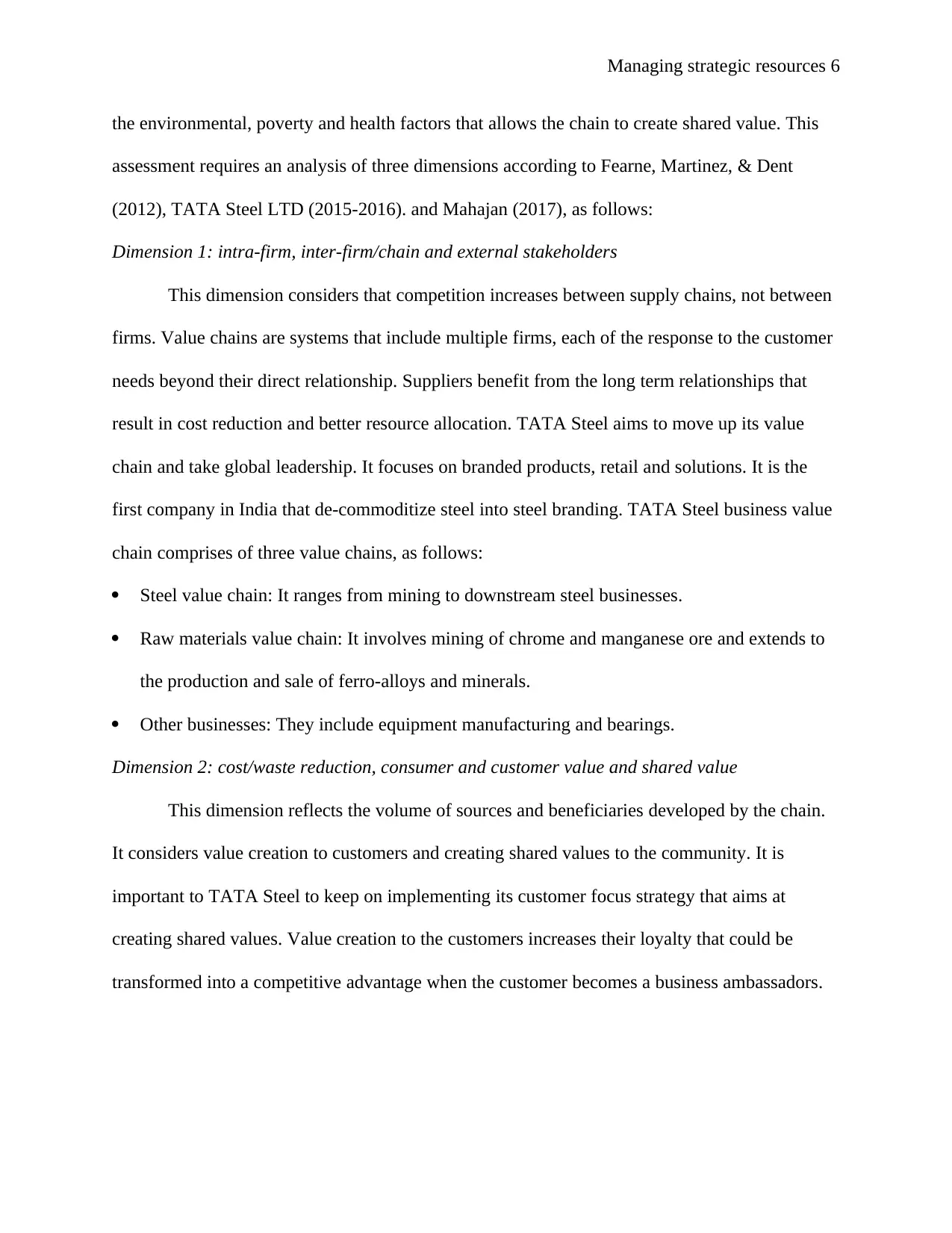
6Managing strategic resources
the environmental, poverty and health factors that allows the chain to create shared value. This
assessment requires an analysis of three dimensions according to Fearne, Martinez, & Dent
(2012), TATA Steel LTD (2015-2016). and Mahajan (2017), as follows:
Dimension 1: intra-firm, inter-firm/chain and external stakeholders
This dimension considers that competition increases between supply chains, not between
firms. Value chains are systems that include multiple firms, each of the response to the customer
needs beyond their direct relationship. Suppliers benefit from the long term relationships that
result in cost reduction and better resource allocation. TATA Steel aims to move up its value
chain and take global leadership. It focuses on branded products, retail and solutions. It is the
first company in India that de-commoditize steel into steel branding. TATA Steel business value
chain comprises of three value chains, as follows:
Steel value chain: It ranges from mining to downstream steel businesses.
Raw materials value chain: It involves mining of chrome and manganese ore and extends to
the production and sale of ferro-alloys and minerals.
Other businesses: They include equipment manufacturing and bearings.
Dimension 2: cost/waste reduction, consumer and customer value and shared value
This dimension reflects the volume of sources and beneficiaries developed by the chain.
It considers value creation to customers and creating shared values to the community. It is
important to TATA Steel to keep on implementing its customer focus strategy that aims at
creating shared values. Value creation to the customers increases their loyalty that could be
transformed into a competitive advantage when the customer becomes a business ambassadors.
the environmental, poverty and health factors that allows the chain to create shared value. This
assessment requires an analysis of three dimensions according to Fearne, Martinez, & Dent
(2012), TATA Steel LTD (2015-2016). and Mahajan (2017), as follows:
Dimension 1: intra-firm, inter-firm/chain and external stakeholders
This dimension considers that competition increases between supply chains, not between
firms. Value chains are systems that include multiple firms, each of the response to the customer
needs beyond their direct relationship. Suppliers benefit from the long term relationships that
result in cost reduction and better resource allocation. TATA Steel aims to move up its value
chain and take global leadership. It focuses on branded products, retail and solutions. It is the
first company in India that de-commoditize steel into steel branding. TATA Steel business value
chain comprises of three value chains, as follows:
Steel value chain: It ranges from mining to downstream steel businesses.
Raw materials value chain: It involves mining of chrome and manganese ore and extends to
the production and sale of ferro-alloys and minerals.
Other businesses: They include equipment manufacturing and bearings.
Dimension 2: cost/waste reduction, consumer and customer value and shared value
This dimension reflects the volume of sources and beneficiaries developed by the chain.
It considers value creation to customers and creating shared values to the community. It is
important to TATA Steel to keep on implementing its customer focus strategy that aims at
creating shared values. Value creation to the customers increases their loyalty that could be
transformed into a competitive advantage when the customer becomes a business ambassadors.
⊘ This is a preview!⊘
Do you want full access?
Subscribe today to unlock all pages.

Trusted by 1+ million students worldwide
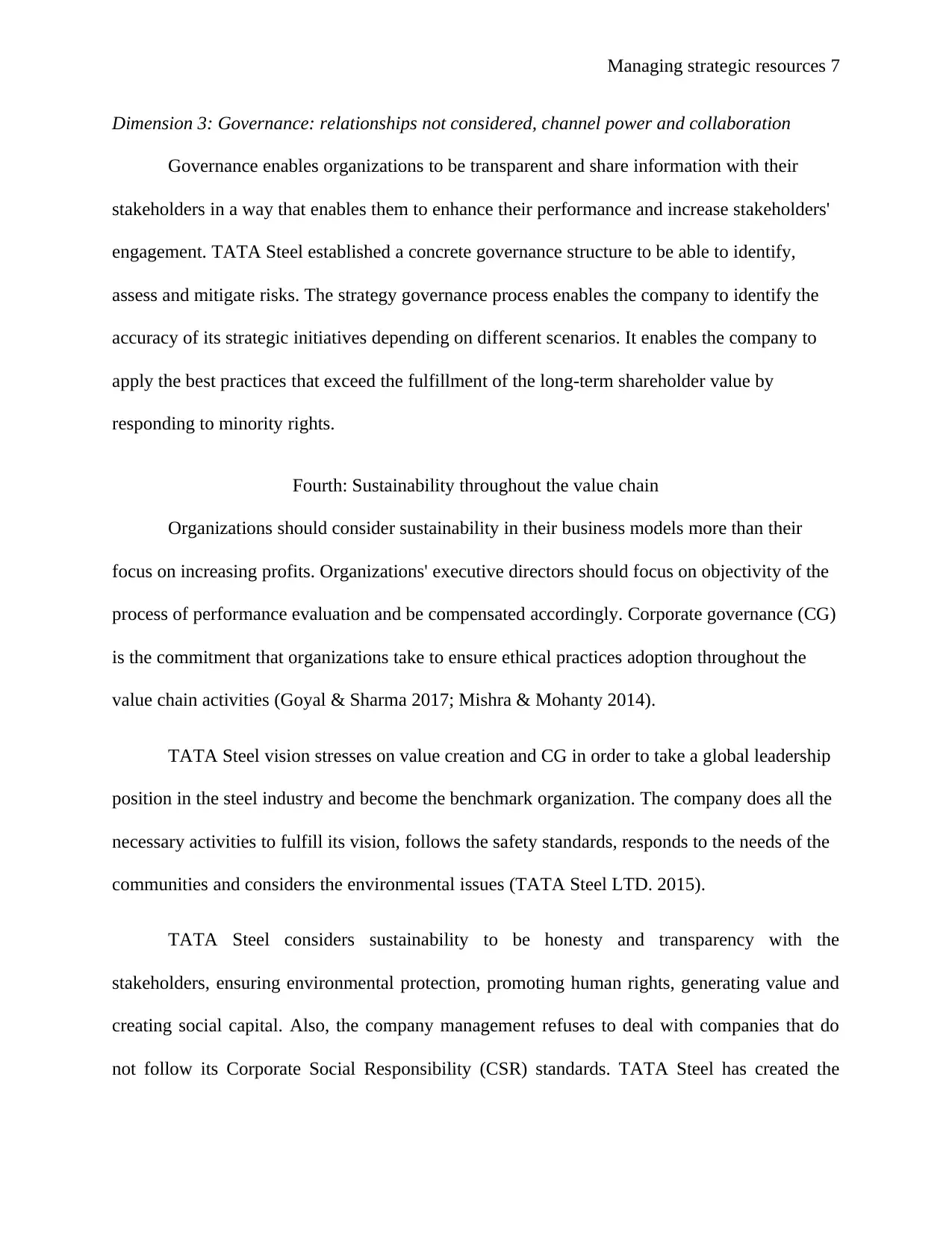
7Managing strategic resources
Dimension 3: Governance: relationships not considered, channel power and collaboration
Governance enables organizations to be transparent and share information with their
stakeholders in a way that enables them to enhance their performance and increase stakeholders'
engagement. TATA Steel established a concrete governance structure to be able to identify,
assess and mitigate risks. The strategy governance process enables the company to identify the
accuracy of its strategic initiatives depending on different scenarios. It enables the company to
apply the best practices that exceed the fulfillment of the long-term shareholder value by
responding to minority rights.
Fourth: Sustainability throughout the value chain
Organizations should consider sustainability in their business models more than their
focus on increasing profits. Organizations' executive directors should focus on objectivity of the
process of performance evaluation and be compensated accordingly. Corporate governance (CG)
is the commitment that organizations take to ensure ethical practices adoption throughout the
value chain activities (Goyal & Sharma 2017; Mishra & Mohanty 2014).
TATA Steel vision stresses on value creation and CG in order to take a global leadership
position in the steel industry and become the benchmark organization. The company does all the
necessary activities to fulfill its vision, follows the safety standards, responds to the needs of the
communities and considers the environmental issues (TATA Steel LTD. 2015).
TATA Steel considers sustainability to be honesty and transparency with the
stakeholders, ensuring environmental protection, promoting human rights, generating value and
creating social capital. Also, the company management refuses to deal with companies that do
not follow its Corporate Social Responsibility (CSR) standards. TATA Steel has created the
Dimension 3: Governance: relationships not considered, channel power and collaboration
Governance enables organizations to be transparent and share information with their
stakeholders in a way that enables them to enhance their performance and increase stakeholders'
engagement. TATA Steel established a concrete governance structure to be able to identify,
assess and mitigate risks. The strategy governance process enables the company to identify the
accuracy of its strategic initiatives depending on different scenarios. It enables the company to
apply the best practices that exceed the fulfillment of the long-term shareholder value by
responding to minority rights.
Fourth: Sustainability throughout the value chain
Organizations should consider sustainability in their business models more than their
focus on increasing profits. Organizations' executive directors should focus on objectivity of the
process of performance evaluation and be compensated accordingly. Corporate governance (CG)
is the commitment that organizations take to ensure ethical practices adoption throughout the
value chain activities (Goyal & Sharma 2017; Mishra & Mohanty 2014).
TATA Steel vision stresses on value creation and CG in order to take a global leadership
position in the steel industry and become the benchmark organization. The company does all the
necessary activities to fulfill its vision, follows the safety standards, responds to the needs of the
communities and considers the environmental issues (TATA Steel LTD. 2015).
TATA Steel considers sustainability to be honesty and transparency with the
stakeholders, ensuring environmental protection, promoting human rights, generating value and
creating social capital. Also, the company management refuses to deal with companies that do
not follow its Corporate Social Responsibility (CSR) standards. TATA Steel has created the
Paraphrase This Document
Need a fresh take? Get an instant paraphrase of this document with our AI Paraphraser
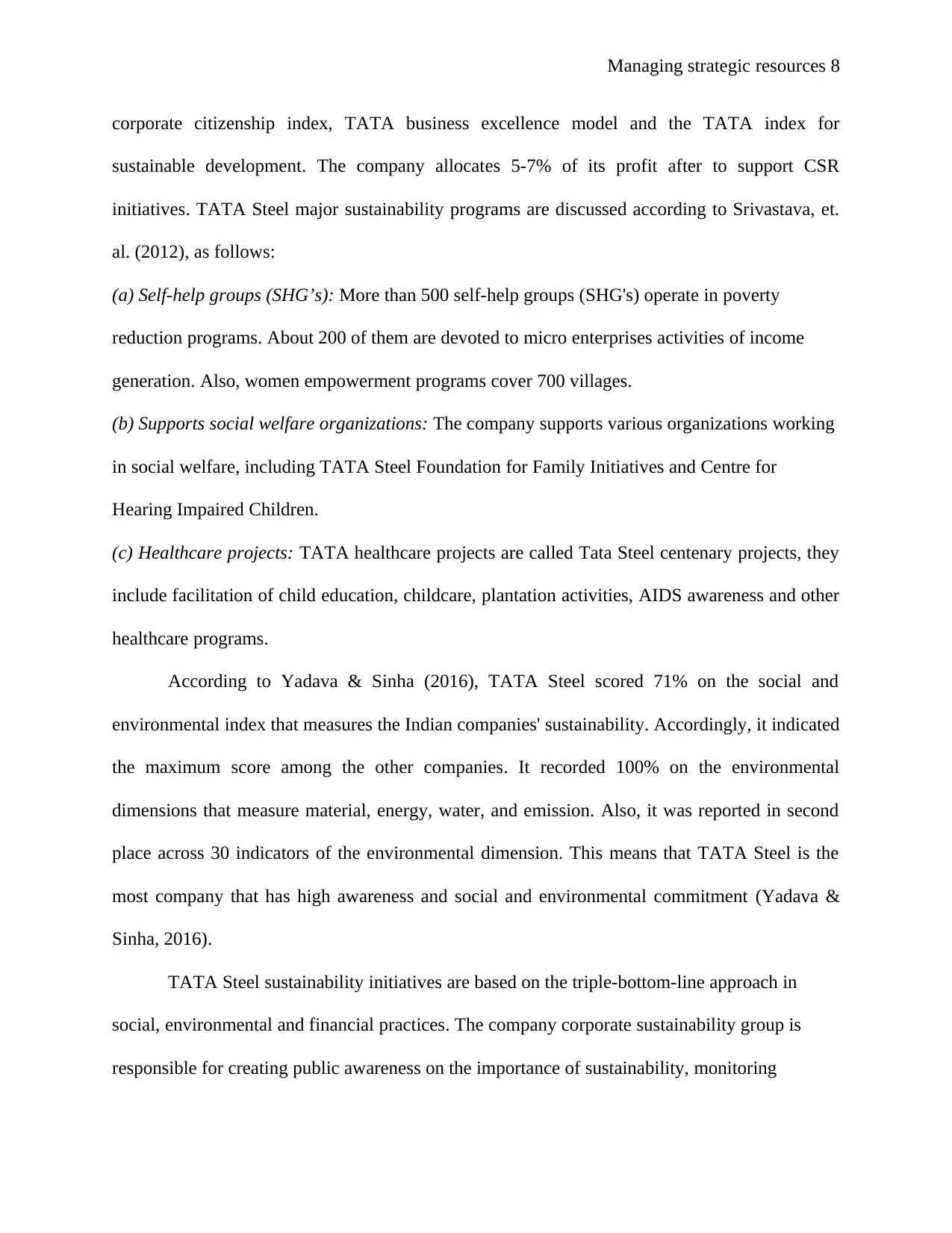
8Managing strategic resources
corporate citizenship index, TATA business excellence model and the TATA index for
sustainable development. The company allocates 5-7% of its profit after to support CSR
initiatives. TATA Steel major sustainability programs are discussed according to Srivastava, et.
al. (2012), as follows:
(a) Self-help groups (SHG’s): More than 500 self-help groups (SHG's) operate in poverty
reduction programs. About 200 of them are devoted to micro enterprises activities of income
generation. Also, women empowerment programs cover 700 villages.
(b) Supports social welfare organizations: The company supports various organizations working
in social welfare, including TATA Steel Foundation for Family Initiatives and Centre for
Hearing Impaired Children.
(c) Healthcare projects: TATA healthcare projects are called Tata Steel centenary projects, they
include facilitation of child education, childcare, plantation activities, AIDS awareness and other
healthcare programs.
According to Yadava & Sinha (2016), TATA Steel scored 71% on the social and
environmental index that measures the Indian companies' sustainability. Accordingly, it indicated
the maximum score among the other companies. It recorded 100% on the environmental
dimensions that measure material, energy, water, and emission. Also, it was reported in second
place across 30 indicators of the environmental dimension. This means that TATA Steel is the
most company that has high awareness and social and environmental commitment (Yadava &
Sinha, 2016).
TATA Steel sustainability initiatives are based on the triple-bottom-line approach in
social, environmental and financial practices. The company corporate sustainability group is
responsible for creating public awareness on the importance of sustainability, monitoring
corporate citizenship index, TATA business excellence model and the TATA index for
sustainable development. The company allocates 5-7% of its profit after to support CSR
initiatives. TATA Steel major sustainability programs are discussed according to Srivastava, et.
al. (2012), as follows:
(a) Self-help groups (SHG’s): More than 500 self-help groups (SHG's) operate in poverty
reduction programs. About 200 of them are devoted to micro enterprises activities of income
generation. Also, women empowerment programs cover 700 villages.
(b) Supports social welfare organizations: The company supports various organizations working
in social welfare, including TATA Steel Foundation for Family Initiatives and Centre for
Hearing Impaired Children.
(c) Healthcare projects: TATA healthcare projects are called Tata Steel centenary projects, they
include facilitation of child education, childcare, plantation activities, AIDS awareness and other
healthcare programs.
According to Yadava & Sinha (2016), TATA Steel scored 71% on the social and
environmental index that measures the Indian companies' sustainability. Accordingly, it indicated
the maximum score among the other companies. It recorded 100% on the environmental
dimensions that measure material, energy, water, and emission. Also, it was reported in second
place across 30 indicators of the environmental dimension. This means that TATA Steel is the
most company that has high awareness and social and environmental commitment (Yadava &
Sinha, 2016).
TATA Steel sustainability initiatives are based on the triple-bottom-line approach in
social, environmental and financial practices. The company corporate sustainability group is
responsible for creating public awareness on the importance of sustainability, monitoring
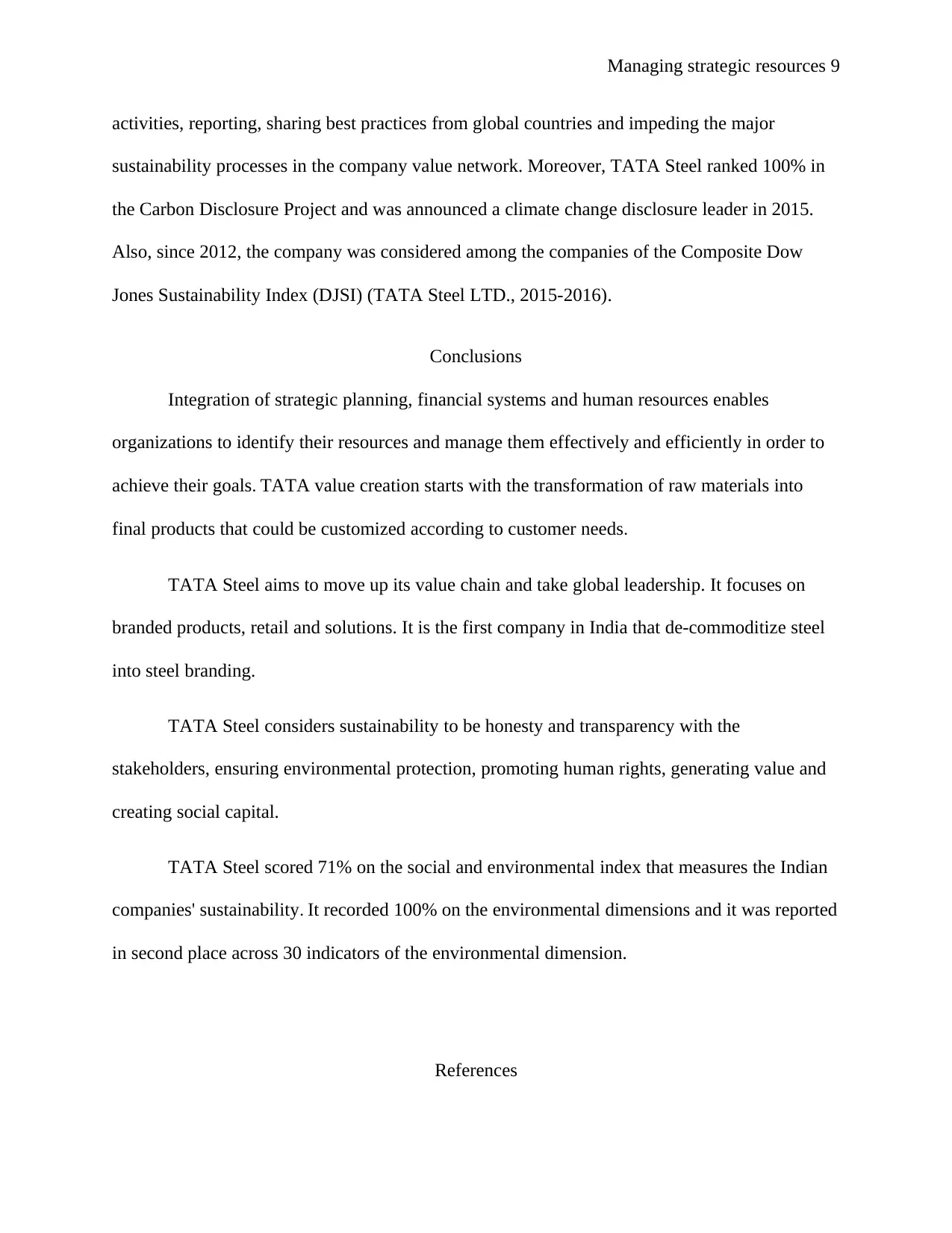
9Managing strategic resources
activities, reporting, sharing best practices from global countries and impeding the major
sustainability processes in the company value network. Moreover, TATA Steel ranked 100% in
the Carbon Disclosure Project and was announced a climate change disclosure leader in 2015.
Also, since 2012, the company was considered among the companies of the Composite Dow
Jones Sustainability Index (DJSI) (TATA Steel LTD., 2015-2016).
Conclusions
Integration of strategic planning, financial systems and human resources enables
organizations to identify their resources and manage them effectively and efficiently in order to
achieve their goals. TATA value creation starts with the transformation of raw materials into
final products that could be customized according to customer needs.
TATA Steel aims to move up its value chain and take global leadership. It focuses on
branded products, retail and solutions. It is the first company in India that de-commoditize steel
into steel branding.
TATA Steel considers sustainability to be honesty and transparency with the
stakeholders, ensuring environmental protection, promoting human rights, generating value and
creating social capital.
TATA Steel scored 71% on the social and environmental index that measures the Indian
companies' sustainability. It recorded 100% on the environmental dimensions and it was reported
in second place across 30 indicators of the environmental dimension.
References
activities, reporting, sharing best practices from global countries and impeding the major
sustainability processes in the company value network. Moreover, TATA Steel ranked 100% in
the Carbon Disclosure Project and was announced a climate change disclosure leader in 2015.
Also, since 2012, the company was considered among the companies of the Composite Dow
Jones Sustainability Index (DJSI) (TATA Steel LTD., 2015-2016).
Conclusions
Integration of strategic planning, financial systems and human resources enables
organizations to identify their resources and manage them effectively and efficiently in order to
achieve their goals. TATA value creation starts with the transformation of raw materials into
final products that could be customized according to customer needs.
TATA Steel aims to move up its value chain and take global leadership. It focuses on
branded products, retail and solutions. It is the first company in India that de-commoditize steel
into steel branding.
TATA Steel considers sustainability to be honesty and transparency with the
stakeholders, ensuring environmental protection, promoting human rights, generating value and
creating social capital.
TATA Steel scored 71% on the social and environmental index that measures the Indian
companies' sustainability. It recorded 100% on the environmental dimensions and it was reported
in second place across 30 indicators of the environmental dimension.
References
⊘ This is a preview!⊘
Do you want full access?
Subscribe today to unlock all pages.

Trusted by 1+ million students worldwide
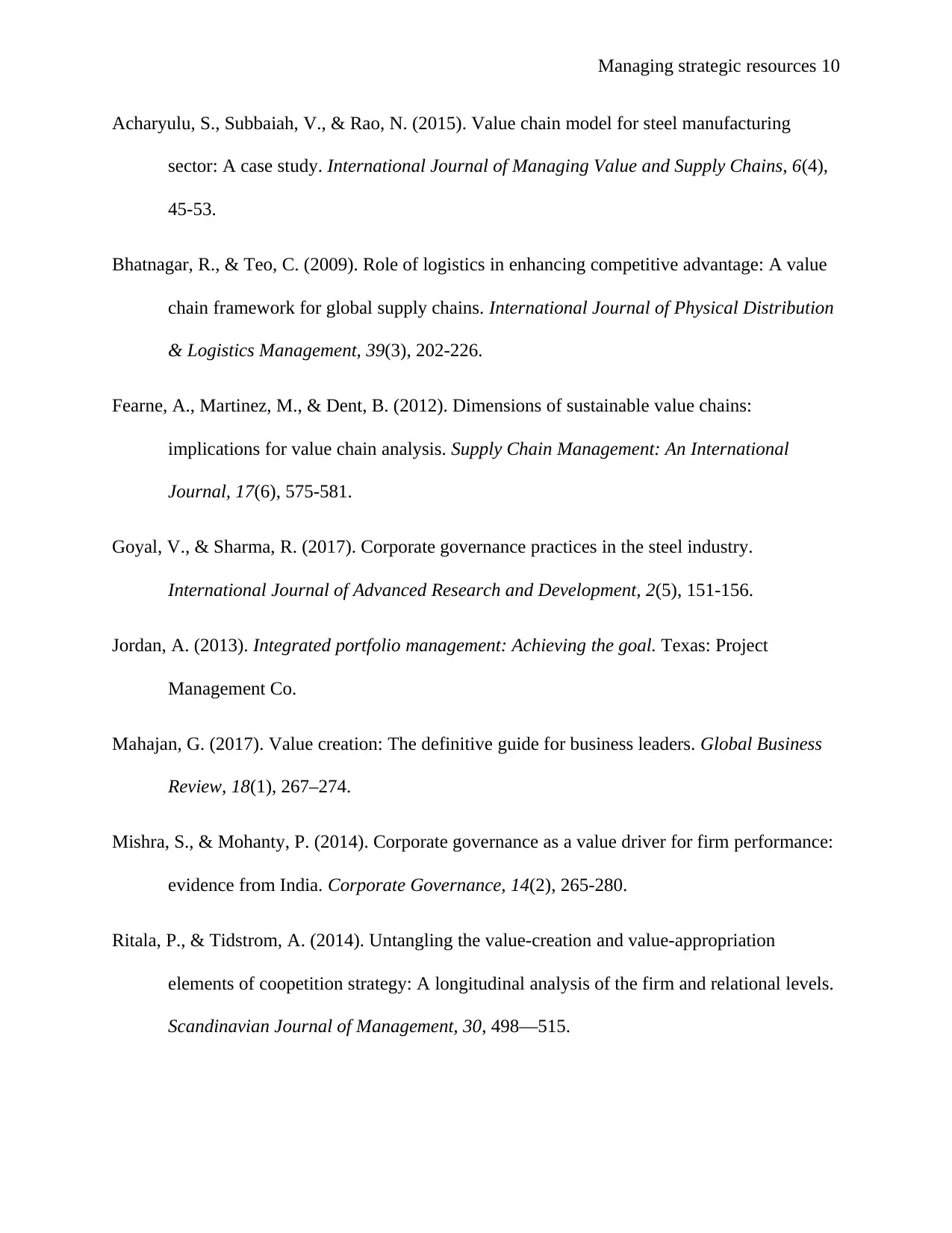
10Managing strategic resources
Acharyulu, S., Subbaiah, V., & Rao, N. (2015). Value chain model for steel manufacturing
sector: A case study. International Journal of Managing Value and Supply Chains, 6(4),
45-53.
Bhatnagar, R., & Teo, C. (2009). Role of logistics in enhancing competitive advantage: A value
chain framework for global supply chains. International Journal of Physical Distribution
& Logistics Management, 39(3), 202-226.
Fearne, A., Martinez, M., & Dent, B. (2012). Dimensions of sustainable value chains:
implications for value chain analysis. Supply Chain Management: An International
Journal, 17(6), 575-581.
Goyal, V., & Sharma, R. (2017). Corporate governance practices in the steel industry.
International Journal of Advanced Research and Development, 2(5), 151-156.
Jordan, A. (2013). Integrated portfolio management: Achieving the goal. Texas: Project
Management Co.
Mahajan, G. (2017). Value creation: The definitive guide for business leaders. Global Business
Review, 18(1), 267–274.
Mishra, S., & Mohanty, P. (2014). Corporate governance as a value driver for firm performance:
evidence from India. Corporate Governance, 14(2), 265-280.
Ritala, P., & Tidstrom, A. (2014). Untangling the value-creation and value-appropriation
elements of coopetition strategy: A longitudinal analysis of the firm and relational levels.
Scandinavian Journal of Management, 30, 498—515.
Acharyulu, S., Subbaiah, V., & Rao, N. (2015). Value chain model for steel manufacturing
sector: A case study. International Journal of Managing Value and Supply Chains, 6(4),
45-53.
Bhatnagar, R., & Teo, C. (2009). Role of logistics in enhancing competitive advantage: A value
chain framework for global supply chains. International Journal of Physical Distribution
& Logistics Management, 39(3), 202-226.
Fearne, A., Martinez, M., & Dent, B. (2012). Dimensions of sustainable value chains:
implications for value chain analysis. Supply Chain Management: An International
Journal, 17(6), 575-581.
Goyal, V., & Sharma, R. (2017). Corporate governance practices in the steel industry.
International Journal of Advanced Research and Development, 2(5), 151-156.
Jordan, A. (2013). Integrated portfolio management: Achieving the goal. Texas: Project
Management Co.
Mahajan, G. (2017). Value creation: The definitive guide for business leaders. Global Business
Review, 18(1), 267–274.
Mishra, S., & Mohanty, P. (2014). Corporate governance as a value driver for firm performance:
evidence from India. Corporate Governance, 14(2), 265-280.
Ritala, P., & Tidstrom, A. (2014). Untangling the value-creation and value-appropriation
elements of coopetition strategy: A longitudinal analysis of the firm and relational levels.
Scandinavian Journal of Management, 30, 498—515.
Paraphrase This Document
Need a fresh take? Get an instant paraphrase of this document with our AI Paraphraser
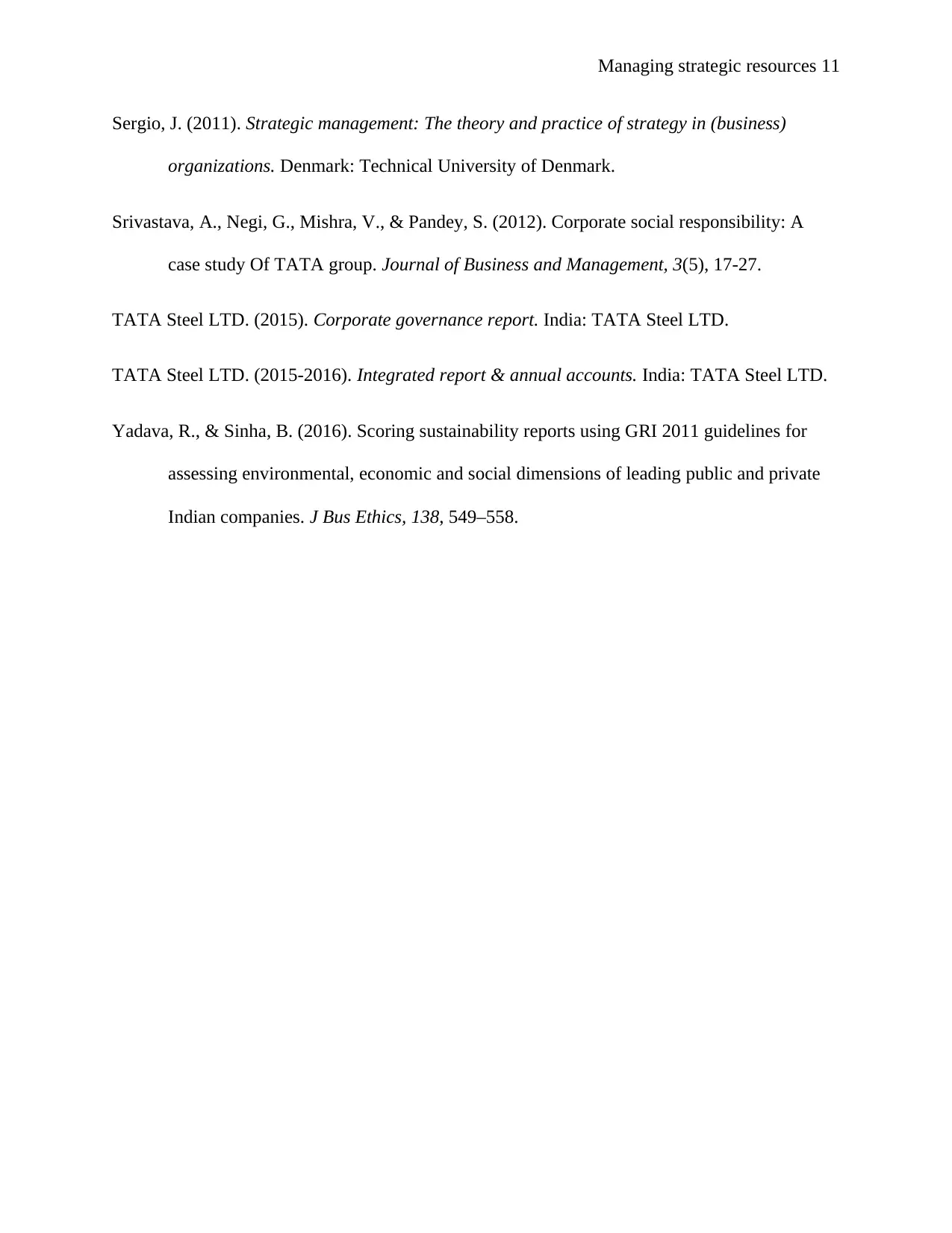
11Managing strategic resources
Sergio, J. (2011). Strategic management: The theory and practice of strategy in (business)
organizations. Denmark: Technical University of Denmark.
Srivastava, A., Negi, G., Mishra, V., & Pandey, S. (2012). Corporate social responsibility: A
case study Of TATA group. Journal of Business and Management, 3(5), 17-27.
TATA Steel LTD. (2015). Corporate governance report. India: TATA Steel LTD.
TATA Steel LTD. (2015-2016). Integrated report & annual accounts. India: TATA Steel LTD.
Yadava, R., & Sinha, B. (2016). Scoring sustainability reports using GRI 2011 guidelines for
assessing environmental, economic and social dimensions of leading public and private
Indian companies. J Bus Ethics, 138, 549–558.
Sergio, J. (2011). Strategic management: The theory and practice of strategy in (business)
organizations. Denmark: Technical University of Denmark.
Srivastava, A., Negi, G., Mishra, V., & Pandey, S. (2012). Corporate social responsibility: A
case study Of TATA group. Journal of Business and Management, 3(5), 17-27.
TATA Steel LTD. (2015). Corporate governance report. India: TATA Steel LTD.
TATA Steel LTD. (2015-2016). Integrated report & annual accounts. India: TATA Steel LTD.
Yadava, R., & Sinha, B. (2016). Scoring sustainability reports using GRI 2011 guidelines for
assessing environmental, economic and social dimensions of leading public and private
Indian companies. J Bus Ethics, 138, 549–558.
1 out of 11
Related Documents
Your All-in-One AI-Powered Toolkit for Academic Success.
+13062052269
info@desklib.com
Available 24*7 on WhatsApp / Email
![[object Object]](/_next/static/media/star-bottom.7253800d.svg)
Unlock your academic potential
Copyright © 2020–2025 A2Z Services. All Rights Reserved. Developed and managed by ZUCOL.





